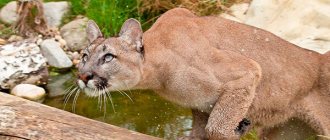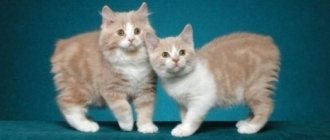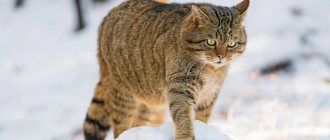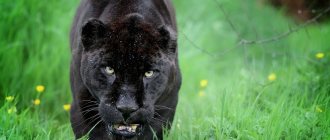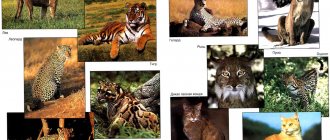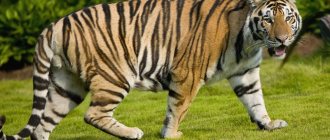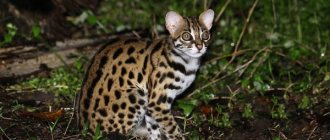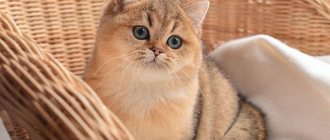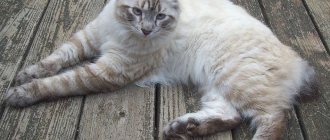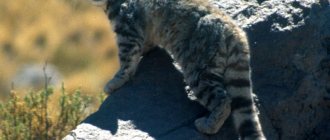Description of the African golden cat
Unfortunately, it is only possible to admire the beauty and grace of a wild cat in a zoo. Even very little video of this animal in nature has been filmed. Naturalists and animal photographers consider a meeting with a predator to be a special success - a rare animal tries not to let a person get close to it. Young animals are more carefree - they are caught on camera much more often than cautious adults.
The golden cat is twice the size of a domestic cat
External data
The golden cat is twice the size of the average domestic cat - the body length reaches 80–85 centimeters, plus a 30-centimeter tail. The height of a large male at the withers is up to 55 centimeters, and his weight is up to 14 kilograms. Females weigh almost half as much, since sexual dimorphism in this species is very pronounced.
A lean, muscular body harmonizes with high, strong paws - cats are very mobile and jumping. The hind legs of the animal are shorter than the front ones, and thanks to this, predators are able to make huge jumps not only from heights, but also while moving on a flat surface. The small round head is crowned with rather large triangular ears and decorated with unusually expressive gray-green eyes.
The golden cat has a very expressive look
There are two subspecies of the golden cat, the numbers of which are approximately equal:
- Profelis aurata aurata;
- Profelis aurata celidogaster.
Within both subspecies, pure black kittens are periodically born - up to four percent of the total number of the species is melanistic.
Character and lifestyle
The golden cat is calm and balanced in everyday life, but in extreme moments it is characterized by aggressiveness and unbridled courage. When saving cubs from a person or a large predator, the female is capable of self-sacrifice. These animals enter into fights with obviously stronger opponents and are able to put them to flight.
The golden cat is a very brave animal
The animal leads a solitary, secretive, predominantly nocturnal lifestyle. The wild cat hunts most often at night, and usually sleeps most of the day, climbing higher on a tree. She generally climbs trees very well and quickly hides in their crowns in moments of danger; swims well and masterfully climbs almost vertical mountain slopes.
African woman spends a lot of time in trees
The golden cat is the ideal huntress. Her movements are precise, precise and absolutely silent; She is endowed with excellent sense of smell, sensitive hearing and sees equally well in the dark and in bright daylight. Creeping very close to the prey on soft paws, the predator makes a murderous jump at the right moment - they successfully attack their prey.
Golden cat likes to hunt from ambush
Video: golden cat in natural conditions
Nutrition
Golden cats are gourmets and prefer variety to abundance of food. They include a wide variety of prey in their menu:
- rodents;
- birds;
- hyraxes;
- small ungulates;
- monkeys
The golden cat obtains food at night by attacking sleeping prey
After a hearty meal, you can sleep
Reproduction
During mating games - at the end of winter - single cats form pairs, then the male leaves his girlfriend, and she has to solve all the problems with raising offspring alone. The expectant mother carefully selects a secluded, well-protected place for the den in advance and equips a nest there. After just over two months, at the usual time for most cats, two to four kittens are born.
In nature, cats form a pair only during love games.
Golden cat cubs are characterized by rapid development - their eyes open very early, already at the age of a week. The mother keeps them on a “milk diet” for up to one and a half months, then gradually switches them to regular food. The process of upbringing and training continues until about eight months, after which young animals go into independent life.
Golden cat kitten begins to explore the world
Character and lifestyle
The Asian golden cat is a carnivorous animal that is predominantly nocturnal. During the day, Temminka sleeps in the thickets of tropical trees, and at dusk she goes hunting. Animals by nature are loners. It pairs up with other representatives of its own breed only for a short time, for the purpose of procreation.
Temminka are rather shy, cautious and wary animals. They avoid human contact. If there is potential danger, cats prefer to step aside, do not attack first, and avoid direct conflicts and skirmishes. However, if an attack occurs, they can fight, defending themselves, causing quite serious damage to the enemy.
However, these animals themselves are not aggressive. The only exception is the female Asian golden cat, who protects the life and tranquility of her cubs.
For the sake of her offspring, a mother cat will rush at even the largest animal that threatens her babies, and will fight for them to the last.
Animals are characterized by excellent hearing and acute vision, allowing them to hunt and survive in a wild, natural environment. Asian golden cats prefer to spend their time free from hunting and searching for food sleeping, resting and gaining strength. These animals are not very active and mobile.
Temminka zealously guard their territory and do not tolerate the invasion of uninvited guests. When living in captivity, as a rule, they show a fairly peaceful and balanced character, although without much interest in humans.
Habitat
The living space of this animal, in contrast, covers the equatorial part of Central and Western Africa. Habitat: tropical rainforests, mangroves and bamboo thickets, wetlands, coastal thickets. It is found at altitudes up to 3.5 thousand meters; in search of prey it can wander into dry forests and clearings.
The population size does not exceed 10 thousand individuals. Animal migration is limited by natural barriers. Most of the predators live in the Congo River basin. Deforestation and degeneration of rain forests, a decrease in food supply, and poaching cause irreparable damage to the species. The animal is listed in the Red Book.
Security status
The golden cat is classified as Near Threatened by the IUCN. Recent reports indicate that African golden cat populations are declining, largely due to habitat deforestation. Hunting also plays a minor role in reducing animal populations. Hunting restrictions have been enacted in the following countries: Angola, Benin, Burkina Faso, Republic of the Congo, Ghana, Cote d'Ivoire, Kenya, Liberia, Nigeria, Rwanda, Sierra Leone and the Democratic Republic of the Congo. The golden cat is listed on Appendix II of the Convention on International Trade in Endangered Species (CITES).
African golden cat / Profelis aurata
History of the study The African golden cat (Profelis aurata) is a predatory mammal of the cat family.
Distribution The golden cat lives in the tropical rain forests of equatorial Africa, occurring from Senegal to northern Angola and from Congo in the west to southern Kenya in the east. Its main population lives in the Congo Basin and surrounding areas.
Appearance She is twice the size of a domestic cat. Body length is 0.9-1.2 m, with the tail accounting for 2/7-1/3 of the total length; height at withers - 38-50 cm. Average weight of males - 11-14 kg; the only female weighed was only 6.2 kg. Her ears are rounded and dark on the outside; the head is small. There are two main color variants: golden/red-brown or silver-gray/bluish-gray. The number of animals of both colors is approximately equal. Typically, a golden cat's chest, belly, and throat are lighter or white in color; There is a light border around the eyes. The central dark line is clearly visible on the tail; the tip of the tail is brown or black. The general background has a darker (not black) pattern, which differs between two different subspecies: Profelis aurata aurata lives in Central Africa, from Congo to Uganda; he has spots only on his stomach and sides; Profelis aurata celidogaster is found in West Africa; This subspecies has spots on the back, neck and head. Melanistic animals are also known, colored black, with darker spots visible in the main color - these cats account for 4% of the total number. The golden cat bears a striking resemblance to Temminck's cat (Catopuma temminckii), but they are not related species, but the result of convergent evolution in similar habitats.
Reproduction In captivity, golden cats reproduce well. Their pregnancy lasts 75-78 days, only 1-2 kittens are born. Kittens grow quickly - their eyes open a week after birth, and their mother feeds them milk for up to 6 weeks. At the age of 18 months they become completely independent. In captivity, it lives up to 15 years.
Lifestyle The habitat of the African golden cat is dense tropical rainforests (including mangroves), tall deciduous rainforests. It is found on alpine heathlands, rising into the mountains up to 3600 m above sea level. Along water sources it moves into drier areas (dry forests, coastal thickets, clearings). Leads a nocturnal lifestyle. It hunts in the dark and rests on tree branches during the day. Loves water and often hunts in swampy areas. The African golden cat has an unpleasant body odor and the smell of its excrement. Leads a solitary lifestyle. The size of an individual plot is 24-48 km.
Diet The diet of the golden cat includes rodents, hyraxes, birds, small antelopes (duikers) and monkeys. Does not disdain the remains of the eagles' prey.
The population of the Golden Cat is included in the CITES Convention (Appendix II). Currently, the population size is estimated at about 10 thousand mature individuals. The main threat to the species is the degradation of forests in equatorial Africa.
African Golden Cat and Man The local population (pygmies living in Cameroon) believe that the tail of the African Golden Cat brings good luck during hunting. Cat skins are used as ritual clothing. There are unconfirmed reports of cats attacking domestic animals, incl. goats, sheep and chickens.
Puberty and reproduction
Knowledge of the reproductive habits of the African Golden Cat is based solely on the individual characteristics of animals living in captivity.
The female gives birth to one or two kittens after a gestation period of about 75 days. Cubs weigh between 180 and 235 g. Their eyes open within a week of birth and they are weaned at 6-8 weeks.
Babies grow and develop very quickly compared to other small cat species.
The Golden Cat kitten is capable of climbing to a height of about 40 cm at 16 days after birth, reflecting the cubs' high degree of physical agility from an early age.
Females reach sexual maturity at the age of 11 months, and males at about 18 months. In captivity they live up to 12 years. Their lifespan in the wild is unknown.
Felis (Catopuma) temmincki
A big cat with a beautiful golden brown coat. The animal is extremely rare, leads a very secretive lifestyle, and therefore has been little studied. It is extremely rarely kept in zoos. Inhabitant of the high mountain forests of Burma, Vietnam, Laos, northeastern India, southeastern China.
Top articles : Luxurious British Longhair cat
Her large yellow eyes with changing pupils indicate the nocturnal lifestyle of their owner. In the dark they glow emerald green. The front legs are shorter than the hind legs, so when the golden cat is in a hurry, it moves in large leaps, pushing off with its hind legs and jumping on its front legs. The golden cat is very similar to the cougar, except for color and size (the cougar is much larger). And absolutely cat-like retractable claws and a pink nose and powerful paw pads.
This inhabitant of the tropical rainforests of Africa, even among wild cats, stands out for its slenderness and stature. Its length is 0.90 - 1.20 m, the tail accounts for 2/7 - 1/3 of the total length, that is, the tail is larger than that of the golden cats of Asia. The color of the animal is very diverse: chestnut-brown, red, brown, gray-brown, silver-gray, bluish-gray and even black individuals. The ears are rounded, dark outside; the head is small; legs are high. The pattern on the upper side of the body is the same color as the main color, only a little darker.
As the color darkens, the pattern on the animal's coat may disappear completely. The inside of the legs, belly, chest, cheeks and chin are white, the throat and underside of the tail are lightly colored. There are two blackish stripes on the cheeks; large black spots on the stomach; Narrow transverse stripes composed of small specks are visible on the chest and throat. There are wide transverse stripes on the inside of the legs. A light border is usually visible around the eyes. There are two varieties of African golden cat; in the western, coastal, pattern on the fur coat is more noticeable; Inhabitants of the interior of Africa tend to have darker fur (especially on the head), so the pattern sometimes becomes indistinguishable. However, one variety smoothly passes into another, and their habitat areas also imperceptibly connect. There are some similarities between the African golden cat and the ocelot.
From a geographic point of view, it is registered in the tropical region, but it also lives in the highlands. Countless long hairs not only fit tightly together, but are also covered with a layer of fat. This fur coat will reliably protect you from dampness in cold fogs. For night life, nature has generously rewarded the golden cat with a whole complex of very important qualities - acute vision, excellent hearing and an exceptionally fine sense of smell. The golden cat can sneak up completely silently on such sensitive creatures as wild goats, antelopes and mountain birds. And more mature and experienced cats dare to hunt even wild buffalos. She hunts in the same way as most nocturnal cats. The golden cat, as a typical predator, feeds exclusively on animal food. The golden one leads a solitary lifestyle, wandering in search of food over a fairly large territory. A fellow tribesman who accidentally wanders into someone else's living space is expelled quickly and decisively.
Golden cats form a pair only during the breeding season. Now little is known about the family habits of the golden cat. At the end of March - beginning of April, from two to four kittens appear. Kittens are born blind. After some time they become overgrown with brown fur. Blind babies are very similar to domestic kittens, only bigger. Like domestic kittens, they love to play with each other. Often the mother also participates in the games. By November, the kittens are already able to feed themselves. By this time, the fur of the young becomes golden brown, like that of adult animals. Male golden cats do not take part in feeding and raising the cubs and live completely separately from the family.
Features of temperament
The Temminka Cat has no enemies in the wild, as it is a very cautious and even timid animal, and also an extremely intelligent hunter.
The almost complete disappearance of this beautiful cat from the face of our planet is on human conscience. Temminka never attacks first; when meeting people, she prefers to retreat and hide in the forest thickets. The exception is when the mother guards the den with kittens. In this case, the female will desperately defend her offspring and fearlessly rush at the person with a menacing roar and a specific squeal. Despite its not very large size, the predator is capable of causing significant injuries due to its sharp, strong claws and large fangs.
Temminki, like most average wild cats, live alone, are excellent at climbing trees, but still spend most of their time on the ground. This is a territorial predator that does not allow relatives into its zone, protects its possessions, marking them with physiological secretions and scratches on tree trunks.
An adult male is able to control up to 50 square meters. km. area, female – up to 35.
Being a crepuscular animal, Temminka's Cat is most active in the early morning and evening. The lifestyle of small populations may vary depending on their preferred prey.
During cloudy and rainy periods, Temminki can hunt around the clock, covering up to 5-7 km per day.
This is an excellent hunter with amazing eyesight and a keen sense of smell, who is able to almost silently get close to his prey and wait for the right moment in the bushes for many hours.
It has a powerful jump and usually kills prey by breaking the neck and biting the back of the head. The Asian golden cat is not able to run for a long time and quickly, so it does not pursue fast-moving animals. They never kill prey for reserve, they eat only fresh meat, so they go out hunting every day and never return to the den without lunch.
They usually spend the night in trees, making a den in large hollows. Cats living in the Himalayas often create burrows abandoned by other animals in rock crevices or between tree roots.
Kitties on Cleo - List of breeds
| Pedigree cats AbyssinianAmerican CurlAmerican ShorthairBurmeseBalineseBengalBobtailBombayBritish ShorthairBurmeseEuropean Shorthair Carthusian (Chartreuse) KoratManx, CymrikMaine Coon American RaccoonNeva MasqueradeNorwegian ForestOcicatPersianRagdolRexRussian Blue, NibelungSiamese, ThaiSiberianSingaporeSokokeSomaliSphynxTurkish, Angora, Van TonkineseForine, Oriental (Eastern), Havanese Scottish fold, Highland foldExotic ShorthairJavanese | Wild cats Jungle catCaracal LionLeopardSmoky leopardManul Margay Nubian OncillaOcelotPampas Puma Desert (Velvet) catFishermanLynx ServalTemminka Tiger Black-footed catJaguarJaguarundi African wildcat Bengal dwarfBorneo or Kalimantan catCheetah Gobi (Chinese) catEuropean or Forest di kaya Geoffroy Golden cat Irbis (Snow leopard) Iriomote (Japanese wild) cat |
Description of the golden cat
This animal is beautiful and graceful. It is quite modest, which makes it even more mysterious.
External features
The cat has rounded, dark ears on the outside and a small head. The animal's legs are long, especially the hind legs. It can reach 120 cm in length and up to 50 cm at the withers. The weight of the largest cat encountered by humans is 14 kg. Its color ranges from golden to gray-brown, with leopard spots on its body. Western representatives have them on the back and head, while individuals living in the east can “boast” spots on the sides and abdomen. The cat's eyes are blue. Her coat is of medium hardness, thick and short. There are black cats (about 4% of all individuals).
Approximately 4% of golden cats are black.
Character
The character of the cat is little known, but it is known that it is a modest and timid animal, preferring to flee in case of danger. It tries not to catch the eye of a person, but can behave aggressively.
At the zoo, the golden cat behaves calmly and sleeps all the time. And in enclosures she is more relaxed - she jumps in the trees and behaves quite actively. My friend's neighbors have such a pet. According to them, the cat does not behave like a pet at all, despite the fact that they took it in when it was little. At first she played with them and behaved like a completely ordinary kitten, but soon she became wild, which is quite natural.
Habitat
The cat lives in Central Africa. Most often the animal is found in the Congo River basin. This cat also lives in East Africa (Kenya). Most often it can be found in the following areas:
- tropical forests;
- bamboo and mangroves;
- coastal thickets;
- wetland.
The golden cat can be found in the rainforest
Nutrition
The cat often lives close to human habitations and does not attack livestock. Usually the animal hunts the following representatives of the fauna:
- antelope;
- monkeys;
- birds:
- rodents
Reproduction
The animal's litter is small - usually 1-2 kittens. Kittens open their eyes in the second week of life. They feed on mother's milk for up to two months. Their adult life begins at 1.5 years. In captivity, males sometimes help cats raise their cubs.
Health characteristics and breed diseases
The Asian golden cat is a fairly robust and strong animal, with a good immune system, not prone to hereditary and genetic diseases. Health problems usually arise when kept at home, lack of exercise, and poor diet. With good care, an animal can live about 15 years, maintaining health, vigor and excellent physical shape.
Golden Asian cats are very beautiful and unusual. But, despite their sharp mind and fairly calm disposition, these animals are not intended to be kept at home, since they are real predators, which is reflected in their diet, behavioral model, and relationships with both other pets and with a person.
Description of the species
The weight of a black-footed cat ranges from 1.5 kg. And the average body length is 10-20 cm. The wild African cat has a stocky, strong body, a large round head and expressive eyes that flicker in the dark with a bright blue light. Animals see well at night. In addition, their hearing and sense of smell are highly developed.
The ant tiger's appearance is very deceiving. At first glance, it looks like a domestic pussycat, but in fact it is a fierce African predator. The color of the animal's fur can vary from light yellow to red-brown. The cat's color is complemented by a pattern of black spots, which sometimes merge into stripes. This camouflage coloring camouflages the predator well, making it invisible to enemies and prey. Dense fur on the paw pads reliably protects cats from the hot desert sand.
Habitat and role of the African black-footed cat in the ecosystem
The small black-footed cat lives in the southern regions of the African continent in deserted open dry plains, in savannas and steppes with occasional thickets of low bushes and tufts of grass.
Traces of this animal were found in the following countries:
- SOUTH AFRICA;
- Angola;
- Namibia;
- Botswana;
- Zimbabwe.
Best articles: Aardvark - a prehistoric animal that lives today
In the wild, the black-footed cat lives in the dry desert regions of Africa.
There are two types of miniature predators living in different places:
- Felis nigripes thomasi - in Botswana (sparsely inhabited areas of the Kalahari Desert), distinguished by a more contrasting and darker fur color;
- Felis nigripes nigripes - in Namibia (Karoo plateau) in dry grassy areas, individuals of this species are smaller in size and their coat is paler.
The small tiger cat is found only in the northern regions of South and southern Central America. It lives in the subtropical and tropical forests of Brazil, Venezuela, French Guiana, Argentina, Costa Rica, Uruguay, Suriname, Guyana, Paraguay, Ecuador and Peru. In these areas it is quite widespread, but it can be seen extremely rarely due to its low numbers and secrecy.
The tiger cat prefers to live in tropical rainforests
The typical habitat of these small predators is tropical evergreen montane cloud forests, wet thickets of eucalyptus trees, forest clearings, savannas, abandoned semi-arid land areas densely overgrown with thorny bushes. The species successfully inhabits subtropical forests at altitudes from 1500 to 3200 meters.
A tiger cat can live in a deforested forest
Currently, several subspecies of oncilla are known, which differ in color, coat length and habitat:
- Leopardus tigrinus pardiniodes - Peru, Colombia, western regions of Venezuela, Ecuador, Northern Andes;
- Leopardus tigrinus tigrinus - northern and eastern regions of Brazil, Guiana, Costa Rica, eastern Venezuela, Guyana;
- Leopardus tigrinus guttulus - center and south of Brazil, Paraguay, Uruguay, northern regions of Argentina.
We invite you to read: Prednisolone for cats: in what cases is it prescribed and what should be taken into account. Prednisolone for cats - rules for safe use
There is no precise data on the potential role of small spotted cats in the ecosystem. But, being terrestrial predators, they help in the fight against excess numbers of rodents and other pests.
Description and natural habitat
Temminka was originally classified as a member of the golden cat family, but today this classification has been abolished. The beast is considered and is a descendant of Kalimantan or Barneo cats.
This is a fairly large animal, at least twice the size of a regular domestic cat. The average length from the nose to the tip of the tail is 90-95 cm. A strong muscular body with powerful paws is covered with thick short hair of brown or golden shades, although there are also melanistic cats in natural gray or black tones. The color is more of a tabby, although the golden hairs are ticked. The body may have sparse spots and streaks, and the muzzle has characteristic charcoal-white stripes.
Sometimes this wild cat also appears on coffee plantations and open forest areas.
Depending on the region where it lives, the size of the Temminka Cat varies greatly. The smallest specimens barely reach 60 cm in length, and the largest ones are more than a meter. Height at the withers is from 35 to 55 cm. Weight ranges from 10 to 17 kg.
The head is not particularly large compared to the powerful body with fairly long and strong legs.
The eyes are not too large and not very wide apart. They are often brownish or golden in color. The nose is wide and large with a large, brick-colored nose.
The ears are medium in size with slightly rounded tips and set quite high.
The tail is long, up to 50 cm, wide at the base and slightly tapering to a rounded tip.
The coat is short, dense and hard, the skin has well-developed sebaceous glands. Therefore, each hair is covered with a layer of lubricant, which protects the animal in mountainous areas from overheating and hypothermia during sudden temperature changes.
The chest, abdominal area, inner side of the paws are of a lighter, almost beige shade, more like “coffee with milk”.
A dark brown stripe runs along the back to the tip of the tail.
In the rays of the sun, the animal’s fur actually shimmers, as if drenched in molten gold, which is why the animal is called the Fire Cat.
Living conditions and food at home
In addition to sufficient free space, Asian golden cats require a warm climate. The optimal temperature for keeping these tropical animals is from +20 to +28°C. Temminka are loners, protecting their territory; they do not like contact with other animals.
In the enclosure where the animal is planned to be kept, the following areas must be equipped:
- The house is for relaxation and privacy.
- The walking area is a free space with access to sunlight.
- A comfortable and safe place for feeding, a drinking bowl with clean water.
- The play area is spacious, equipped with multi-level structures, stones, snags, and trees. It is required to maintain good shape of the animal and provide the physical activity it needs.
Serious difficulties in keeping cats at home arise in connection with feeding cats. These predators simply need live meat - rabbits, food rodents, etc. Only with this diet do Temminkas get all the nutrients, minerals and vitamins they need.
When trying to feed beef, pork, poultry and other meats that are unusual for them, Asian golden cats develop serious problems with the functioning of the gastrointestinal tract and digestive system, which can kill the animal.
It is imperative to include specialized vitamin and mineral supplements in the diet. Dry food and dairy products are definitely not suitable for the Asian golden cat.
Find out what other breeds of wild cats exist:
- forest cat;
- ocelot;
- Chilean cat.
Life in captivity
The predator has an aggressive character, is difficult to tame, and is unpredictable. More suitable for keeping in a specially equipped spacious enclosure. The animal must be under the supervision of a veterinarian, receive age-appropriate vaccinations and a balanced diet. The diet consists of lean meat, feed mice, poultry, eggs, vitamin supplements, and fish.
You can legally buy a golden cat only in a specialized nursery that breeds exotic animals. The price of a golden cat depends on the intensity of the color of the skin, the age of the animal, acquired skills, and pedigree. The initial cost is $10 thousand.
The Federation of European Cat Fanciers has compiled a rating of the most desirable representatives of these animals.
And if the list of the most popular breeds has remained almost unchanged: the top five are Persians, Siamese, Sphynxes, Devon Rexes, exotics, then the top list of the most desirable includes the world's super expensive purrs. And they all look very much like little leopards. This is because they were crossed with the closest relatives of these amazingly beautiful wild cats. Introducing the top three. All of them were produced in the USA.
So she was called Asherah
The Ashera breed, or mini-leopard, is recognized as the most expensive and desirable breed in the world. This miracle was developed in 2006 by scientists from the biotechnological company Lifestyle Pets based on the genes of the African serval, Asian leopard cat and the common domestic cat. The leopard kitty weighs up to 14 kg and reaches a meter in length.
As the owners of the strange animals assure, although the Asher is formidable in appearance - powerful paws and an animal grin - it is an ideal pet. In terms of habits, it is an ordinary cat. She is easy to care for, non-aggressive, loves to sleep and eat delicious food, and play with children. Plus, Ashers are the only representatives of the cat family that can be led along the streets on a leash.
Despite the fact that a kitten costs a lot of money (the price for the simplest one is from $22,000 to $27,000), buying one is not easy. Those who want to take a “designer” kitty into their home must sign up for a waiting list a year in advance - the company does not raise more than 100 cats per year. You also need to pay a $6,000 deposit.
Today there are four varieties of the breed - regular Ashera, snow (similar to a white tiger), hypoallergenic and royal. The latter differs from the usual one in that the spots on its caramel-colored skin are not black, but orange. It is the Royal Asherah that can be called the rarest cat in the world. No more than four such kittens are born per year. This mini leopard starts at $125,000.
The largest is the savannah
In addition to being expensive, this cat is the largest and most similar to a wild cat of all the hybrids. There is not a single such kitten in our country, and the closest animal to us lives in Riga. The price for this beauty starts from $4000, and for a breeding one - from $8000. Savannah is the fruit of love between a wild Serval cat and an ordinary domestic cat. The cat looks like dad - large, long-legged, long-necked, with huge ears. It is almost impossible to make any sudden movements next to a cat - the animal will instantly rush towards the “whistling” object. At the same time, there is no anger or aggression - only automatism and reflexes. They are still working on this young and not yet completely domesticated breed, which also affects the cost: the price starts from $4,000 to $10,000.
Savannah (pictured) looks like his dad, a wild Serval cat: large, long-necked, with huge ears.
The Bengal girl is burning!
And if the previous cats did not yet have famous fans, the Bengal cat won the hearts of both Hollywood stars and the richest people on the planet.
Recently, the Sultan of Brunei and actor, producer and director Kevin Bacon became the owners of super-elite Bengal kittens. The joy of owning him cost $145,000. But if they wanted to buy the main sire of the California cattery Almaden cat Zeus, they would have to fork out another $200,000.
Best articles: Caracal, or steppe lynx
For comparison: an ordinary kitten of this breed costs from $800 to $3000. This breed is very capricious and requires special care.
The Bengali woman won the hearts of both Hollywood stars and the richest people on the planet.
The Bengal cat also looks like a miniature leopard or jaguar. They began to breed it back in the 60s by crossing simple muroks with wild leopard cats. Normal, that is, domesticated offspring, were obtained only about fifteen years ago.
There are also Bengal cats in Russia; the best ones live in a cattery in Samara. A simple kitten can be bought for up to $1,500, and one that looks like the pet of the Sultan of Brunei can be purchased for up to $4,500.
Original post and comments at
Previously it belonged to the genus Profelis
.
History of the discovery of the species and subspecies
Recent genetic analysis has shown that the Golden Cat is closely related to caracals, and has therefore been placed in the genus Caracal instead of Profelis. That is, we can say that Profelis aurata is its old name, and Caracal aurata is new.
In addition, the Golden Cat is extremely similar to the Temminck's Asian golden cat, but they should not be confused, their habitats never intersect.
Felis aurata is the scientific name used by the great Dutch zoologist and director of the Natural History Museum, Conrad Jacob Temminck, who in 1827 described the tawny skin of a cat that he bought from a merchant in London. Temminck also characterized a gray zoological specimen with chocolate brown spots, the animal lived in a menagerie in London. He named it Felis Celidogaster.
The name Felis neglecta, proposed by the British scientist Sir John Edward Gray in 1838, was accompanied by a description based on a zoological specimen with a brownish-gray skin from Sierra Leone.
Felis rutilus is another name and description proposed by another English naturalist, George Robert Waterhouse, in 1842, based on the skin of a ginger cat from the same place (from Sierra Leone).
In 1906, the English naturalist, geologist and writer Richard Lydekker gave his characteristics and name to the species - Felis chrysothrix cottoni, using the dark gray cat skin of an animal from the Ituri rainforest as a standard.
In 1942, a completely black representative of the African Golden Cat was also discovered in eastern Congo. In 1858, the famous Russian explorer and naturalist Nikolai Alekseevich Severtsov proposed the generic names Profelis instead of F. celidogaster and Chrysailurus instead of F. neglecta as the type name for the subspecies of the Golden Cat.
In 1917, British zoologist Reginald Innes Pocock proposed that Asian and African Golden cats be placed in the genus Profelis, a classification supported by several subsequent prominent zoologists around the world.
Phylogenetic analysis of cat samples has shown that the African golden cat is closely related to the caracal (Caracal caracal). These two species, together with the serval (Leptailurus serval), form a common lineage, one of eight in the cat family Felidae. This branch originated almost 8.5 million years ago. Because of this close relationship, the African Golden Cat was placed in the genus Caracal.
Since 2022, the largest felinologists have recognized two African subspecies of Golden cats as valid:
- Caracal aurata aurata (the authorship of the subspecies belongs to Temminck and dates back to 1827) - these populations live east of the Congo River.
- Caracal aurata celidogaster (Temminck, 1827) - Colonies of these cats live in the western valleys of the Cross River.
Kinds
Golden Britons are a special color of cats. However, it is not integral - there are several subgroups of golden cats:
- shaded;
- veiled;
- tabby (which includes ticked, spotted, tabby and marbled).
Let's look at each of the above types in more detail.
Shaded British. This cat has a rather original color. Thus, the lower part of the hairs on the coat is colored in golden and apricot shades. A characteristic feature is also the presence of a so-called white collar. This group is quite common within the British Golden breed.
Purchasing a Temminka kitten
This animal is now listed in the first CITES appendix, and smuggling is subject to a large fine and even imprisonment. Even large zoos find it difficult to acquire these rare and unique animals.
Only from single foreign breeders, with a long and persistent search, can you find “legitimate” kittens born from cats who themselves grew up in captivity and have all the necessary documents about their origin.
In order to seriously engage in breeding the Temminka Cat and its hybrid species in captivity, a person, first of all, needs to restore the natural population and stop the extinction of this rare animal.
For this purpose and to stop the deforestation of rare tropical forests, various associations have been created, including the World Conservation Organization, which includes a number of government and public companies.
The history of the Temminki cat
Golden Asian cats were first discovered in the late 19th century by Dutch explorer Conrad Jacob Temminck. The species itself was named after this scientist.
This discovery is unusual, since the zoologist believed that he had met African golden cats in the Asian forests and it was precisely how Temminok first described these animals.
Today this predator has several names - Asian Golden, Temminka's Cat, Fiery, Fire Cat.
In its morphology, the animal is very similar to a puma, although much smaller and of a different color.
In nature[edit]
African golden cat
African golden cat
It lives in the tropical forests of equatorial Africa from Snegal to Angola and southern Kenya. The main population lives in the Congo River basin.
Twice the size of a domestic cat, body length up to 1.2 m, at the withers up to 50 cm, color golden-red, hence the name of the species, or silver-gray. The ratio of colors in the population is approximately the same. Typically the chest, belly and throat are lighter or white in color; There is a light border around the eyes. A characteristic feature is a clearly visible dark line running down the center of the tail.
There is very little data on the lifestyle of these animals, so it is not surprising that this cat is still one of the most mysterious representatives of the felines in Africa. In captivity they reproduce well, pregnancy lasts 75-78 days, only 1-2 kittens are born. At the age of 18 months, kittens become completely independent. In captivity, a cat lives up to 15 years.
There are two subspecies of the animal:
- Profelis aurata aurata
- lives in Central Africa, from Congo to Uganda; he has spots only on his stomach and sides; - Profelis aurata celidogaster
- found in West Africa; This subspecies has spots on the back, neck and head.
Melanists, colored black, are also known.
Asian golden cat
Asian golden cat
When people talk about the “Asian golden cat,” they mean Temminck's cat ( Catopuma temminckii
), living in Southeast Asia - Tibet, Nepal, India, which in appearance is really very similar to the African golden one. The similarities between the African and Asian golden cats are believed to be based on convergent evolution. The appearance is approximately the same as that of the African: length up to 90 cm, thick wool, golden or brown in color. Sometimes gray and black specimens are found. In some regions, cats have clearly visible spots all over their bodies and black and white stripes on their faces. In general, it is similar to the lifestyle of the African golden cat, which is due to the fact that both species, despite their territorial remoteness, nevertheless live in approximately the same tropical climate conditions.
In Thailand, there are many legends around the Temminck cat. In one of them she is described as wild and brave, and emerges victorious in a battle with a tiger. It is believed that burning the fur of the Temminka cat drives tigers away from the surrounding area, and carrying at least one hair from its fur, according to local superstitions, protects against tiger attacks.
Three subspecies have been identified:
- Pardofelis temminckii temminckii
lives in the Himalayas, South Asia and Sumatra - Pardofelis temminckii dominicanorum
lives in southern China - Pardofelis temminckii tristis
lives in southeast China
Golden Beast from the Rainforest
It is no coincidence that this African wild cat was called golden, and this is not only because of the bright red fur of the animal, sparkling like polished gold. In the cat family, this interesting animal is rightfully considered one of the rarest, most mysterious and least studied, and local residents endow it with magical properties.
Very little is still known about the life of the golden cat in nature.
Golden or golden?
Two remarkably similar animals - the Asian golden cat (Pardofelis temminckii) and the African golden cat (Profelis aurata) - live, as their names suggest, in Southeast Asia and Equatorial Africa. External similarity, like the similarity of names, periodically provokes considerable confusion. Both cats are sometimes called golden, sometimes golden, sometimes also called fire cats, and the Asian cat has another name - Temminka.
Asian golden cat - not to be confused with the African golden cat
These are completely different species - one can only assume that they turned out to be so similar as a result of similar conditions for evolutionary development, because both species formed in hot tropical forests, where there is a lot of rainfall.
The African is closely related not to the golden Asian, but to other species of cats - servals and caracals. So close that some scientists propose combining the caracal and the African golden cat into one genus.
The African golden cat is a close relative of the caracal.
Habitat and relationships with humans
A significant part of the African golden cat population has settled along the banks of the Congo River in tropical rainforests; the predator lives in various countries of Equatorial Africa: Angola, Kenya, Uganda, Senegal. Representatives of this species are found not only on the plains, but also quite high in the mountains - up to 4 thousand kilometers above sea level.
The habitat of the golden cat is Equatorial Africa, central and western regions
In recent years, tropical forests have been actively developed by humans - they are cut down and burned for agricultural land, and this has a very negative impact on the size of the wild cat population, which is deprived of its habitat. For its part, this proud predator tries to interact with people as little as possible and almost never approaches a human home, not to mention stealing domestic animals for food.
Golden cat tries not to catch the eye of a person
Local residents - mostly pygmies - hunt the animal for ritual and commercial purposes. Aborigines know a lot of mystical stories and legends about the golden cat, sincerely believe in the magical power of its body parts and make talismans from them. For example, in their opinion, the tail of an animal promotes successful hunting of elephants; a necklace of fangs or claws protects against evil forces and diseases. And African priests always use cat skins for ritual clothing. Exotic talismans are in demand among tourists, which again stimulates the natives to exterminate the golden cat.
When going hunting, pygmies hang themselves with the tails of wild cats.
The number of this rare animal is most likely decreasing - research on this matter is very difficult, since the animal leads a secretive lifestyle and avoids humans in every possible way. The last calculations were carried out quite a long time ago, in 1996; then scientists estimated the total population of the African golden cat at only ten thousand adult sexually mature individuals. The latest, less accurate study was carried out in 2011 - according to its data, the population of the species decreased by a thousand individuals.
